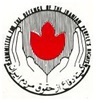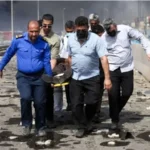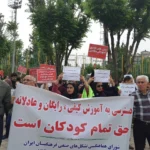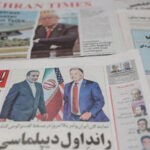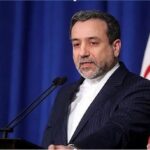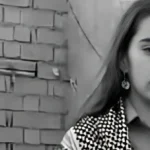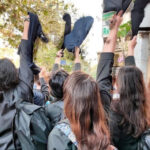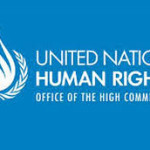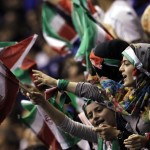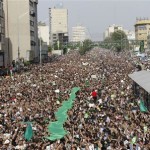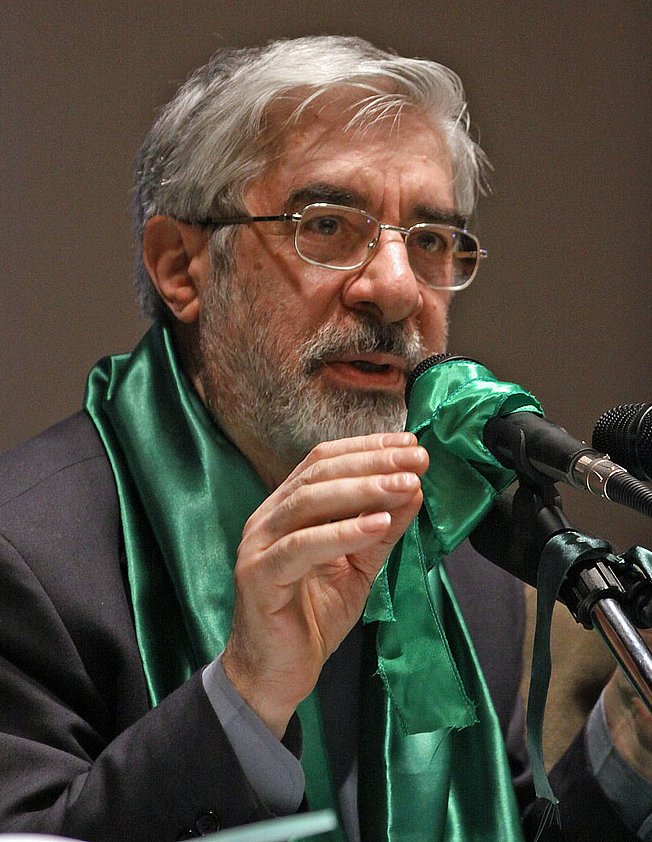
CODIR has been closely following, with growing concern, the developments underway inside Iran pertaining to protests and rallies planned for Friday 14 February. This date marks the 14th anniversary of the incarceration under house arrest of three of the country’s major opposition figures: former prime minister and presidential candidate, Mir-Hossein Mousavi; his wife, prominent academic, Dr. Zahra Rahnavard; as well as senior reformist clergyman and another former presidential candidate, Mehdi Karroubi.
Reports and footage from on the ground detail the swarming of several sites in downtown Tehran, particularly in the vicinity of the iconic gates to the University of Tehran’s main campus, by a huge number of regime security force personnel, uniformed and plainclothes alike, stopping and detaining anyone they suspect to be milling around. This mobilisation of the security forces follows on from the arrests of hundreds more anti-regime activists across Iran in recent days.
Yesterday, on Thursday 13 February, a large protest in front of the University of Tehran was broken up by regime security forces and dozens were detained. Security forces and agents from the Islamic Republic’s notorious Ministry of Intelligence had already moved to arrest several figures, including Rahim Qomeishi, Naser Daneshfar, and Akbar Danesh Sararoudi – all central members of the ‘Campaign to Lift the House Arrest’, a reference to the continuing detention of Mousavi, Rahnavard, Karroubi, and his wife, Fatemeh Karroubi.
Several other well-known activists were also rounded up according to information detailed on the ‘Kaleme’ (‘Word’) news website. These included Mahmoud Dardkeshan and his son, Javad Dardkeshan. Abdolrahim Soleimani Ardestani was placed under house arrest, while Saeed and Saeedeh Montazeri were detained on Enghelab (Revolution) Street in downtown Tehran. The latter two are the son and daughter of the late Grand Ayatollah Hossein-Ali Montazeri, the one-time designate heir apparent to Ayatollah Ruhollah Khomeini, founder of the Islamic Republic, as ‘Supreme Leader’ before becoming persona non grata with the regime following his outspoken condemnation of the notorious massacre of political prisoners in the ‘National Catastrophe’ of summer 1988, which had been sanctioned in a fatwa issued by Khomeini himself.
While most of those detained had been released by Thursday night with warnings to stay away from the gatherings scheduled for the following day, several were confirmed as remaining in custody – including Qomeishi and Daneshvar.
These protests have increased symbolic significance owing to their being organised by a group of senior veterans of the Iran-Iraq War (1980-88), a brutal conflict that devastated both countries and populations, and which continues to haunt them to this day.
The aftermath of the dispersed protest on Thursday and the demonstrations planned for Friday have meant a huge security presence around the University of Tehran, the Pastor neighbourhood of Tehran (in which the closed-off residence of Mousavi and Rahnavard is located), as well as surrounding streets.
In footage which has since been widely shared, Mohammad Baqer Bakhtiar, a former Islamic Revolutionary Guard Corps (IRGC) commander, recorded a video from inside his vehicle showing the security situation in the streets around the University of Tehran as he neared the protest he intended to join. Referring to the decorated war veteran background of many of the protesters, he stated, “These people know exactly what forces they are confronting and how many divisions [of the security forces] are present,” before going on to state that he held ‘Supreme Leader’ Ayatollah Ali Khamenei personally responsible for the woeful current state of the country.
Eyewitness reports cited in the ‘Avaye Kherad’ (‘Voice of Wisdom’) Telegram channel describe between 400 and 500 protesters as having initially been taken to a police station near Enghelab Square where they were held outdoors in freezing conditions before being dispatched in groups to answer a set list of questions.
Hossein Loghmanian, a member of the reformist Union of Islamic Iran People Party, former representative in the 6th Parliament of the Islamic Republic, and veteran of the Iran-Iraq War who lost a leg defending the country, was detained along with his brother at the protest in front of the University of Tehran. Despite his background and credentials, Loghmanian has been detained and imprisoned by the Islamic Republic authorities several times before. Given his physical condition, there are grave concerns for his safety and welfare.
Rahim Qomeishi, a key organiser in the campaign, military veteran, and a prisoner of war for years in Iraq during the Saddam Hussein era, was also arrested by security forces at his address in Tehran. Qomeishi had previously gone on record as stating, “The 13 February gathering is uncancellable under any pretext. Even if those under house arrest [Mousavi, Rahnavard, and the Karroubis] are released, we will still gather to meet with them and reiterate that [other] political prisoners must also be freed. We demand the addressing of the people’s economic conditions. We want to say that no illegal action is permissible in this country, whoever it may be on the part of, and that this country belongs to all the people of Iran – not just an entitled and selected few.”
On the eve of her 14th year under house arrest, Zahra Rahnavard released a statement headed “Coercive Kidnapping” which described how security forces blindfolded, gagged, and chained both her and her husband (Mousavi) before driving them to a remote basement holding facility on the first night of their detention. “Now we are labelled the ringleaders of sedition – a term created in 1388 (2009) by the leader of tyranny [‘Supreme Leader’ Ayatollah Ali Khamenei],” read one part of her statement.

_____________________________________________
Mir-Hossein Mousavi served as the 45th and last prime minister of Iran, from 1981 to 1989, before the post was abolished as one of the amendments to the country’s constitution in the wake of the death of Ayatollah Khomeini that year. He is generally regarded as having represented the more liberal left-oriented tendency in the Islamic Republican movement, and earned some degree of popular acclaim for his skilful undertaking of his responsibilities as a civil leader as well as careful stewardship of the national economy during a complex and fraught period in the country’s history, with the Iran-Iraq War raging throughout and the country more or less completely isolated internationally. Following the abolition of his post, Mousavi was not invited to take part in the subsequent government headed by president Hashemi Rafsanjani and largely disappeared from the public sphere.
In early 2009, in response to demands by the masses who desired change and saw him as the only one able to really challenge the dictatorship and deal with the multifaceted systemic crisis that had taken hold in Iran, as well as having received the backing of the former reformist president Mohammad Khatami (1997 to 2005) and indeed the entire reformist movement, he stood for president.
His campaign for the presidency saw huge nationwide rallies take place, with the country’s women, youth, workers, and pro-reform intellectuals roundly and enthusiastically getting behind his candidacy. By all accounts from election observers – including some conservatives and officials from within the regime machinery – by the end of Friday 12 June 2009, the day of the ballot, it was clear that Mousavi had prevailed and won outright with a strong mandate from the people of Iran.
However, the theocratic regime, fearing what this victory might mean for the survival of the system they had hitherto overseen, were simply not prepared to accept the results. By the following morning, the regime moved to silence those officials who would testify to Mousavi’s victory and then falsified the results of the previous day’s ballot on a massive scale before declaring that the incumbent president, Mahmoud Ahmadinejad, had won a second term. The voting figures and margins declared by the regime across several major districts were highly suspect where not impossible. Interestingly, such was the regime’s anxiety at the prospect of Mousavi’s victory that the election was rigged in the first round rather than allowing the contest to proceed to a second-round run-off between Mousavi and Ahmadinejad.
In the hours that followed, regime security forces and paramilitaries were mobilised to attack Mousavi’s campaign offices and any supporters attempting to gather in the streets.
A huge protest movement began to take shape – named the ‘Jonbesh-e Sabz’ (‘Green Movement’) – reflecting Mousavi’s campaign theme with connotations of an Iranian Spring, Awakening, or Green Revolution. Despite horrific levels of violence meted out to demonstrators and an announcement by the regime that any protest against the election result was illegal and would be met with force – thus greenlighting the regime’s security forces to do their worst – an estimated 3 million Iranians took to the streets of Tehran on Monday 15 June under the slogan, ‘Where is My Vote?’ The demonstration, the largest seen in Iran since the 1979 Revolution, was Mousavi’s first public appearance after the election. Protesters converged around Azadi Tower, with packed crowds stretching back for over nine kilometres.
Over the weeks and months that followed, thousands of people were brutally attacked, arrested, and detained – including former ministers and well-known political figures from the 1979 Revolution, essentially those previously loyal to the regime. (On 11 August 2009, in what were derided as conservative figures, the Iranian government itself confirmed that 4,000 had been detained in the post-election protests.) Numerous demonstrators and opposition activists were spirited away to the country’s notorious prisons, like Evin, and detention centres, such as Kahrizak, as well as regime black sites across the land. Many were forcibly disappeared.
The mass protests continued to rock Iran until the beginning of February 2010, serving to deliver a crack across the theocratic regime’s edifice of legitimacy – one which it is widely argued the regime has never recovered from. The latter phase of these protests saw the death, while under house arrest, of Grand Ayatollah Montazeri – with hundreds of thousands packing the road between Tehran and the holy city of Qom on the day of his funeral – and the targeted assassination of Seyed Ali Mousavi, Mir-Hossein’s own nephew, who was run over and then shot while walking at the head of a procession of demonstrators in Tehran.
On 14 February 2011, when the largest Green Movement demonstrations in Iran in more than a year broke out, and following public calls by both Mousavi and Karroubi for renewed demonstrations in Iran in light of the uprisings in Egypt and Tunisia, Mousavi, Rahnavard, and the Karroubis were placed under house arrest and their residences more or less completely cut-off from the outside world. Conservative pro-regime parliamentarians publicly called for the execution of Mousavi and Karroubi on the grounds of treason. They have remained under house arrest and isolation ever since, while the 14 February has become an annual flashpoint and rallying call for anti-regime protesters.
In February 2023, a picture of a frail Mir-Hossein Mousavi standing in the snow-covered yard of his residence was released accompanied by a statement of endorsement for the 12-point ‘Freedom Charter’ issued by a coalition of independent trade union and civil organisations in Iran, and warmly recognised by working-class, democratic, and progressive currents inside the country, following the ‘Woman, Life, Freedom’ protests that rocked Iran once more between autumn 2022 and spring 2023. The Charter is now regarded as the authoritative statement of intent of the opposition inside Iran. Mousavi’s public endorsement of the demands was seen as the definitive drawing of a line under the largely unchecked narrative of the right-wing and extreme nationalist monarchists abroad that claims they are the sole arbiters of the future course of developments in a post-Islamic-Republic Iran.
_____________________________________________
CODIR once more reiterates its unequivocal support for the campaign in Iran to free Mir-Hossein Mousavi, Zahra Rahnavard, Mehdi Karroubi, and Fatemeh Karroubi from their long and wholly unjust incarceration, and we echo the sentiment articulated by the campaign’s leading spokesperson, Rahim Qomeishi, that this must be followed by the immediate and unconditional release of all political prisoners detained in Iran safely back to their families and loved ones.
We demand the immediate release of all those still detained for their participation in protests over the last few days in Iran.
We furthermore express our complete support for the demands articulated in the 12-point ‘Freedom Charter’ jointly initiated by several of Iran’s independent trade union and civil organisations and endorsed by the main recognised opposition currents in the country.
Finally, CODIR expresses its sincere hope that the theocratic regime’s culpable officials – from Ayatollah Khamenei down – will soon be brought to account legally by the people of Iran for the manifold abuses and crimes they have presided over.

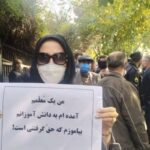
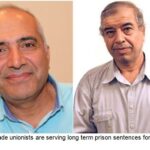
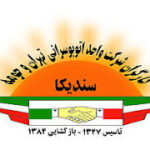

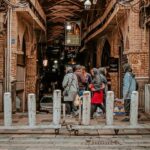
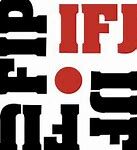
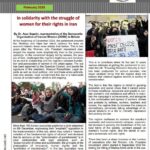


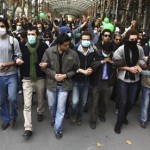
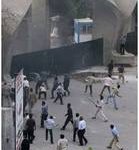
 Posted in
Posted in 